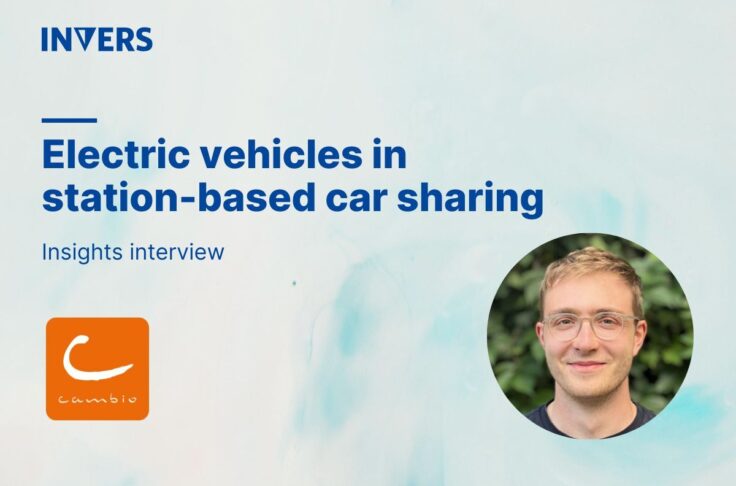Trip to France: The Avant-garde of European Shared Mobility
Summary
Shared mobility providers frequently look at the French market with an eye on entering it or replicating its successes in other countries. We interview local experts to find out what lessons France has learned on its way to becoming a leader in eco-friendly shared mobility operations.

Article contents:
- Introduction
- Origins of shared mobility
- Bumps in the road
- The French market today
- Successful players
- What to know about the French market
Introduction
Eco-mobility refers to an environmentally friendly and socially inclusive way of transportation that includes cycling, walking, public transportation, shared light electric vehicles, and a special focus on inter-modality to tie all those methods together. France is an eco-mobility global leader thanks to its strong political stance on environmental issues and the resulting public policies, including: reducing parking spaces to make cities greener and more people-friendly, major investment in the “electromobility revolution” and infrastructure, and mobility incentive programs dedicated to the private sector.
These measures among others have changed the entire country’s mobility culture and eco-system. They led to a reduction in private car ownership and to an eminent shift towards usage of low-carbon mobility alternatives, a trend that has increasingly become a very high priority in the last three years.
In line with this goal, France was one of the first European countries to commit to a date to phase out internal combustion vehicles, with 2040 set as the deadline for banning sales of non-electric vehicles. Since both consumers and the government chose to go green, the private sector has favored this initiative too. A great example of a country coming together for the greater good.

It’s safe to say that France has got the right idea when it comes to mobility, evidenced by mobility start-ups and established European operators all looking to get into the lucrative French market. Concurrently, large cities look to Paris for insights on how to solve their own mobility deadlocks.

Hence, in this episode we take a trip to France to get the full picture of their mobility landscape. We reached out to Paris-based start-up – Fluctuo – Europe’s leading aggregator of shared mobility data, for expert insights. Below is our interview with their CEO, Julien Chamussy, and Harry Maxwell, their Head of Marketing and Growth.
When, and in what form, did shared mobility first appear in France?
Some may believe that shared mobility services are quite recent (because of the visibility of shared bikes and shared scooters…), but in fact, the first services date back to the 1970s…
The first bike-sharing system appeared in La Rochelle, where 350 Vélos Jaunes were made available for free on the city’s streets. Much later, in the mid-2000s, Lyon and Paris launched Vélo’v and Velib’, respectively. After this, many cities wanted their own bike systems, and JCDecaux, a world leader in OOH (Out of home) advertising and the operator of Velib and Velo’v, launched numerous services with the same hardware from 2005 to 2015. Competitors – such as Clear Channel and Keolis – were quick to follow suit. Shared mobility was officially up and running.
What were some of the early challenges in the shared mobility landscape in France?
It wasn’t all smooth sailing. In 2011, Autolib’ launched its first car sharing service in Paris – the first of its kind. They created the service to complement their bike-sharing operations (Velib’), and it enjoyed some decent success: it had a fleet of nearly 4,000 cars, and there were more than 125,000 registered users. Two years after the launch, Autolib passed the 3 million rentals milestone and then expanded to Lyon and Bordeaux. Unfortunately, Paris’ Autolib’, in Lyon’s BlueLy and Bordeaux’s BlueCub weren’t really successes. Despite these services being remembered fondly, they were all shut down due to vandalism and expensive repairs crippling the available fleet numbers.
Several bike-sharing services that were launched in mid-sized cities like Caen, Perpignan, Angers, Aix en Provence never reached critical mass and, therefore, failed.
The arrival of free-floating bike sharing services in 2017 was met with resistance across Europe, and France was no different. Bikes from companies like Ofo and Mobike arrived en masse and suffered greatly from vandalism.
The mistreatment of vehicles continued into the early days of shared scooters, but thanks to rapid technological advances – such as airless tires, concealed (brake) cables, the introduction of restricted zones, better parking technology and improved IoT to increase rider responsibility – these problems largely went away. Large French cities such as Paris and Marseille continue to have some issues with vandalism, but on a much smaller scale.
How does the French shared mobility market look like today?
France is not dissimilar to any other European market when it comes to shared mobility. There are modes where the market penetration is higher, and some where it is much lower. Let’s explore the market breakdown, mode by mode:
- Bikes: Cities are well-served by bike-sharing, with systems provided by JCDecaux, Ecovelo, Smoove (now Fifteen) and PBSC, among others. In terms of market penetration, the French bike-sharing market is one of the most mature in Europe. Towns and cities of any size can win one of many grants to help grow cycling, usually by the introduction of a bike-sharing system. Shared bike solution provider Fifteen covers each of these in detail in this guide [in French].
- Mopeds: In France, like in Spain and Italy, there is certainly a demand for mopeds. In large cities congestion is a problem for car users, and so mopeds that can move between cars to beat traffic are popular. Another huge benefit of mopeds in French towns is the ability to move beyond the central urban area – something that is not possible on a e-scooter. In smaller towns, mopeds haven’t quite made the same impact as in the Netherlands for example, and there is room to grow for the industry. Here it’s worth mentioning that since the launch of shared e-bikes and escooters that can reach 20/25 km per hour, shared mopeds are being challenged for inner city trips: for the end users, bikes are more convenient (lighter vehicle, allowed in bike lanes, no helmet required, usually cheaper price-per-minute); for operators, bikes and scooters are cheaper to purchase. Mopeds usage comes more into the equation for longer trips and when users want to use high traffic roads (like périphérique = ring roads).
- Scooters: Many cities are backing scooters, but there remain high-profile exceptions, such as Nantes, Toulouse and Nice. Authorities are yet to be convinced of the value they bring over bikes – to which they are more accustomed. This is a particular challenge for cities like Lyon and Paris, who are assessing the utility of such services (e.g. safety, multi-modality, environmental impact).
- Cars: Car-sharing is huge in France. In Paris alone, there are eight different services. Autolib’ – which stopped operations in 2018 – was hugely popular and users remember it fondly, despite the vandalism that its vehicles faced. By-the-minute or by-the-hour rentals are still very popular, the notable players being SHARE NOW, ZITY, Yeah (by Citiz), Leo&Go and Ubeequo. There are also many peer-to-peer services, the most famous being BlaBlaCar and Karos.
Can you name some of the notable French mobility players?
- pony: With a unique business model where the fleet is 50% community-owned, this French operator has been a success across France. Users that ‘adopt a pony’ will get a percentage of each ride on that scooter or bike. pony is present in cities like Bordeaux, Angers, and have managed to expand out of France and into Belgium.
- Cityscoot: This moped sharing service is a favourite in Paris, and can also be found in other cities in France and in Italy. Their success has come from a strong brand image and from forming strategic partnerships. For example, Uber and Cityscoot launched a partnership in 2021 that made Cityscoot mopeds visible in the Uber app in Paris.
- Cooltra: Another favourite in Paris is Cooltra, based out of Barcelona. They have crafted a strong sharing business in the City of Light, with a market share of approx 15%.
- SHARE NOW: After the acquisition by free2move, the company owned by Stellantis is now the world leader in car-sharing. They have a particularly strong presence in Paris and offer services in 15 other European cities, with a total fleet of 10,000 vehicles. Their fully electric offerings and their flexibility of rental options (per minute or per day) has assured their success in the French capital.
What are the notable factors to consider about the French shared mobility market?
1. Cities are cutting the number of operators
Here we selected some of the biggest cities in France to show how the number of providers is carefully controlled.

To win a spot, operators must win a tender…
2. Winning tenders
France is strict on having a ‘Call for Tenders’ (Appel d’Offres) to include any new shared scheme. There is a very strong need for lobbying in France, and having a French speaking person on your team to help you navigate the tender process is essential.
French authorities prefer fewer operators with larger fleets, rather than many with smaller ones. Bordeaux, for example, is the most recent city to clamp down on operator numbers, after selecting just six.
Technology and data are critical to winning a tender. For example, operators in Paris are working hard on computer vision parking technology to improve the parking situation in the city. Operators who don’t have this technology will have a harder time winning tenders or staying in the Paris market. Also, Paris city authorities in collaboration with some operators are piloting noise radars for a while, to reduce noise pollution from loud combustion-engine two-wheelers.
3. Staying power
There is no room for operators that can’t run a reliable service in France. As with any relationship with a city, sharing data on the service is essential to the success of the scheme.
French cities are looking for operators that can prove that their service is:
- Providing value to the community
- Available and affordable to all types of customers
- Carbon neutral (or even carbon negative)
- Having an impact on the modal share (less private car use)
Operators must share data on their fleet sizes, on their rides, and on user satisfaction scores as well as accidents. If operators are using a free-floating model (especially scooters), authorities make sure that they’re not neglecting poorer neighbourhoods by serving only the city center.
In exchange, city authorities are continuously setting new regulations that support environmentally friendly shared-mobility offerings. For example, in Paris “riders of gasoline-fueled motorcycles will have to start paying for parking in Paris from September as the French capital aims to reduce noise and pollution, but parking for electric motorcycles remains free”, as stated by Reuters. This will surely support registration and ridership numbers of local moped sharing operators like Cooltra, Cityscoot, YEGO, and Troopy.
So to wrap it up, what advice would you have for shared mobility start-ups and established players looking to enter the French market?
To put all the points above in a nutshell, when launching in France, don’t try the “ask forgiveness, not permission” approach. It could prove costly. The recruitment of French-speaking employees or consultants is essential for opening dialogues and getting your message across to city officials, most of whom don’t speak other languages. Finally, exploring potential partnerships with public transport companies (e.g. RATP, SNCF, Keolis and more local players) to create synergies is an important step to convince cities that your service will integrate with their existing mobility ecosystem.


